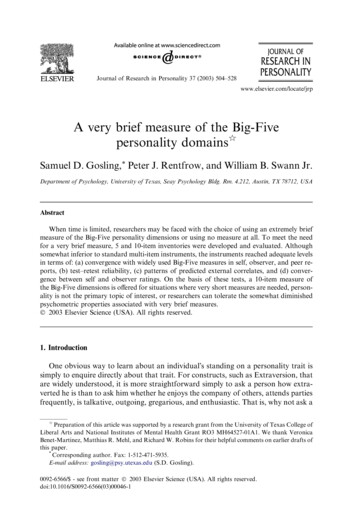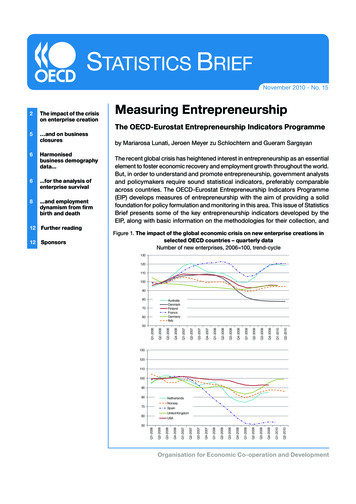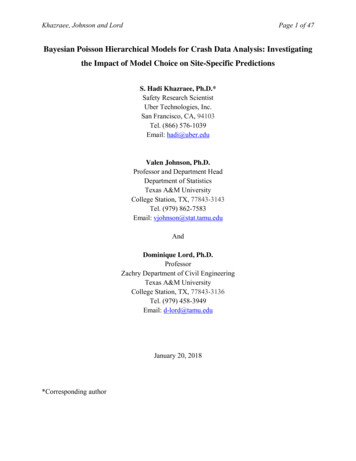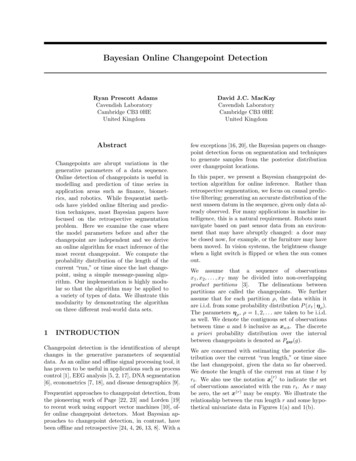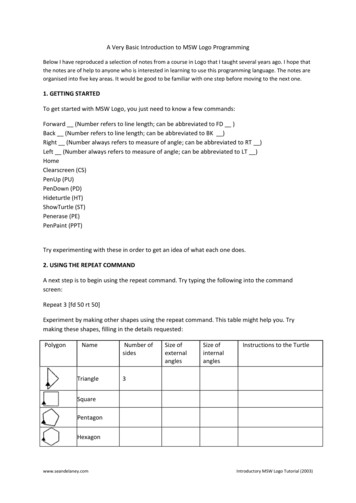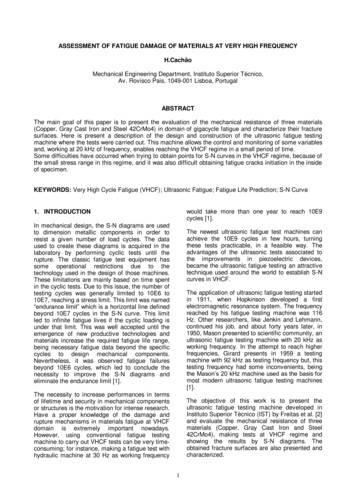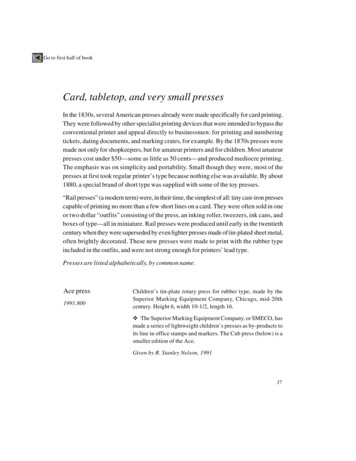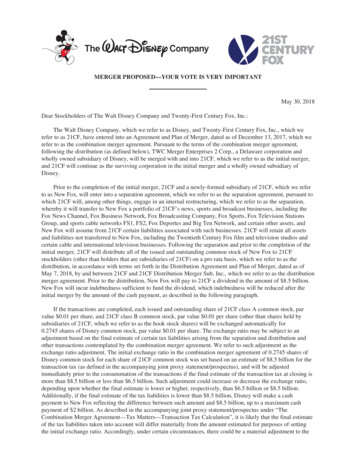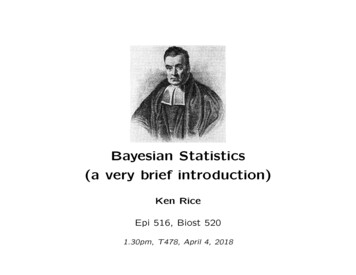
Transcription
Bayesian Statistics(a very brief introduction)Ken RiceEpi 516, Biost 5201.30pm, T478, April 4, 2018
OverviewRather than tryingto cram a PhD’sworth of materialinto 90 minutes. What is Bayes’ Rule, a.k.a. Bayes’ Theorem?What is Bayesian inference?Where can Bayesian inference be helpful?How, if at all, is it different to frequentist inference?Note: the literature contains many pro- and anti-Bayesianpolemics, many of which are ill-informed and unhelpful. I willtry not to rant, and aim to be accurate.Further Note: There will, unavoidably, be some discussion ofepistemology, i.e. philosophy concerned with the nature andscope of knowledge. But.1
OverviewUsing a spade for some jobsand shovel for others doesnot require you to sign upto a lifetime of using onlySpadian or Shovelist philosophy, or to believing thatonly spades or only shovelsrepresent the One True Pathto garden neatness.There are different ways of tackling statistical problems, too.2
Bayes’ TheoremBefore we get to inference: Bayes’ Theorem is a result inconditional probability, stating that for two events A and B.P[ A ]P[ A and B ] P[ B A ].P[ A B ] P[ B ]P[ B ]In this example;1/10 P[ A B ] 3/10 1/31/10 P[ B A ] 5/10 1/55/10 And 1/3 1/5 3/10 (X)In words: the conditional probability of A given B is theconditional probability of B given A scaled by the relativeprobability of A compared to B.3
Bayes’ TheoremWhy does it matter? If 1% of a population have cancer, for ascreening test with 80% sensitivity and 95% specificity;Test PositiveHaveCancerP[ Test ve Cancer ] 80%P[ Test ve] 5.75P[ Cancer ]P[ Cancer Test ve ] 14%. i.e. most positive resultsare actually false alarmsMixing up P[ A B ] with P[ B A ] is the Prosecutor’s Fallacy; asmall probability of evidence given innocence need NOT mean asmall probability of innocence given evidence.4
Bayes’ Theorem: Sally Clark After the sudden death of two baby sons, Sally Clark (above,center) was sentenced to life in prison in 1999 Among other errors, expert witness Prof Roy Meadow (aboveright) had wrongly interpreted the small probability of two cotdeaths as a small probability of Clark’s innocence After a long campaign, including refutation of Meadow’sstatistics, Clark was released and cleared in 2003 After being freed, she developed alcoholism and died in 20075
Bayes’ Theorem: XKCD at the beachThis is roughly equal to# of times I’ve picked upa seashell at the ocean ,# of times I’ve pickedup a seashell.which in my case is prettyclose to 1, and gets much closerif we’re considering only times Ididn’t put it to my ear.6
Bayes’ TheoremBayes’ theorem also applies to continuous variables – say systolicand diastolic blood pressure;The conditional densities of therandom variables are relatedthis way;f (x)f (y).which we can write asf (x y) f (y x)f (x y) f (y x)f (x).This proportionality statementis just a re-wording of Bayes’Theorem.Note: Like probabilities, densities are 0, and ‘add up to 1’.7
Bayesian inferenceSo far, nothing’s controversial; Bayes’ Theorem is a rule aboutthe ‘language’ of probabilities, that can be used in any analysisdescribing random variables, i.e. any data analysis.Q. So why all the fuss?A. Bayesian inference uses more than just Bayes’ TheoremIn addition to describing random variables,Bayesian inference uses the ‘language’ ofprobability to describe what is knownabout parameters.Note: Frequentist inference, e.g. using p-values & confidenceintervals, does not quantify what is known about parameters. *many people initially think it does; an important job for instructors of introStat/Biostat courses is convincing those people that they are wrong.8
Freq’ist inference (I know, shoot me!)Frequentist inference, set all a-quiver;Adapted from Gonick & Smith, The Cartoon Guide to Statistics9
Freq’ist inference (I know, shoot me!)Frequentist inference, set all a-quiver;We ‘trap’ the truth with 95% confidence. Q. 95% of what?10
Freq’ist inference (I know, shoot me!)The interval traps the truth in 95% of experiments. To defineanything frequentist, you have to imagine repeated experiments.11
Freq’ist inference (I know, shoot me!)Let’s do some more ‘target practice’, for frequentist testing;12
Freq’ist inference (I know, shoot me!)Let’s do some more ‘target practice’, for frequentist testing;13
Freq’ist inference (I know, shoot me!)Let’s do some more ‘target practice’, for frequentist testing;14
Freq’ist inference (I know, shoot me!)Let’s do some more ‘target practice’, for frequentist testing;15
Freq’ist inference (I know, shoot me!)For testing or estimating, imagine running your experiment againand again. Or, perhaps, make an argument like this;On day 1 you collect data and construct a [valid] 95% confidenceinterval for a parameter θ1. On day 2 you collect new data andconstruct a 95% confidence interval for an unrelated parameterθ2. On day 3 . [the same]. You continue this way constructingconfidence intervals for a sequence of unrelated parameters θ1, θ2,. 95% of your intervals will trap the true parameter valueLarry Wasserman, All of StatisticsThis alternative interpretation is also valid, but. . neither version says anything about whether your data isin the 95% or the 5% . both versions require you to think about many otherdatasets, not just the one you have to analyzeHow does Bayesian inference differ? Let’s take aim.16
Bayesian inference[Appalling archery pun goes here]17
Bayesian inference[Appalling archery pun goes here]18
Bayesian inference[Appalling archery pun goes here]19
Bayesian inference[Appalling archery pun goes here]20
Bayesian inference[Appalling archery pun goes here]21
Bayesian inferenceHere’s exactly the same idea, in practice; During the search for Air France 447, from 2009-2011,knowledge about the black box location was described viaprobability – i.e. using Bayesian inference Eventually, the black box was found in the red area22
Bayesian inferenceHow to update knowledge, as data is obtained? We use; Prior distribution: what you know about parameter β ,β)excluding the information in the data – denoted π(β Likelihood: based on modeling assumptions, how [relatively]β)likely the data Y are if the truth is β – denoted f (Y βSo how to get a posterior distribution: stating what we knowβ Y)?about β , combining the prior with the data – denoted p(βBayes Theorem used for inference tells us to multiply;β Y) f (Y ββ ) π(ββ)p(βPosterior Likelihood Prior. and that’s it! (essentially!) No replications – e.g. no replicate plane searches Given modeling assumptions & prior, process is automatic Keep adding data, and updating knowledge, as data becomesavailable. knowledge will concentrate around true β23
Bayesian inferenceBayesian inference can be made, er, transparent;Common sense reduced to computationPierre-Simon, marquis de Laplace (1749–1827)Inventor of Bayesian inference24
Bayesian inferencepriorlikelihoodposterior3201Probability density45The same example; recall posterior prior likelihood;0.20.40.60.81.0ParameterA Bayesian is one who, vaguely expecting a horse, and catchinga glimpse of a donkey, strongly believes he has seen a muleStephen Senn, Statistician & Bayesian Skeptic (mostly)25
But where do priors come from?An important day at statistician-school?There’s nothing wrong, dirty, unnatural or even unusual aboutmaking assumptions – carefully. Scientists & statisticians allmake assumptions. even if they don’t like to talk about them.26
But where do priors come from?Priors come from all data external to the current study,i.e. everything else.‘Boiling down’ what subjectmatter experts know/thinkis known as eliciting a prior.It’s not easy (see right) buthere are some simple tips; Discuss parameters experts understand – e.g. code variablesso intercept is mean outcome in people with average covariates, not with age height IQ 0 Avoid leading questions (just as in survey design) The ‘language’ of probability is unfamiliar; help users expresstheir uncertaintyKynn (2008, JRSSA) is a good review, describing many pitfalls.27
But where do priors come from?Ideas to help experts ‘translate’ to the language of probability;Use 20 5% stickers (Johnson etal 2010, J Clin Epi) for prior onsurvival when taking warfarinNormalize marks (Latthe et al2005, J Obs Gync) for prior onpain effect of LUNA vs placebo Typically these ‘coarse’ priors are smoothed. Providing thebasic shape remains, exactly how much you smooth is unlikelyto be critical in practice. Elicitation is also very useful for non-Bayesian analyses – it’ssimilar to study design & analysis planning28
But where do priors come from?If the experts disagree? Try it both ways; (Moatti, Clin Trl 2013)Parmer et al (1996,JNCI)popularizedthe definitions, theyare now common intrials workKnown as ‘Subjunctive Bayes’; if one had this prior and the data,this is the posterior one would have. If one had that prior. etc.If the posteriors differ, what You believe based on the datadepends, importantly, on Your prior knowledge. To convinceother people expect to have to convince skeptics – and notethat convincing [rational] skeptics is what science is all about.29
When don’t priors matter (much)?When the data provide a lot more information than the prior,this happens; (recall the stained glass color-scheme)6402Probability Density8likelihoodprior #1posterior #1prior #2posterior #20.00.20.40.60.81.0ParameterThese priors (& many more) are dominated by the likelihood, andthey give very similar posteriors – i.e. everyone agrees. (Phew!)30
When don’t priors matter (much)?468likelihoodpriorposterior02Probability Density1012A related idea; try using very flat priors to represent ignorance;Parameter Flat priors do NOT actually represent ignorance! Most oftheir support is for very extreme parameter values For β parameters in ‘1st year’ regression models, this ideaworks okay – it’s more generally known as ‘Objective Bayes’ For many other situations, it doesn’t, so use it carefully.(And also recall that prior elicitation is a useful exercise)31
When don’t priors matter (much)?46likelihoodpriorposterior20Probability Density8Back to having very informative data – now zoomed in; β 1.96 stderr β β 1.96 stderrParameterThe likelihood alone(yellow) gives the classic 95% confidence interval. But, to a goodapproximation, it goesfrom 2.5% to 97.5%points of Bayesian posterior (red) – a 95%credible interval. With large samples , sane frequentist confidence intervalsand sane Bayesian credible intervals are essentially identical With large samples , it’s actually okay to give Bayesianinterpretations to 95% CIs, i.e. to say we have 95%posterior belief that the true β lies within that range* and some regularity conditions32
When don’t priors matter (much)?We can exploit this idea to be ‘semi-Bayesian’; multiply what thelikelihood-based interval says by Your prior. For Normal priors ;Prior: β N (µ0, σ02)\ β̂ ]2)Likelihood:approx N ( β̂, StdErr[Posterior: β N µ0w β̂(1 w), 1 ,\ β̂ ]21/σ 2 1/StdErr[01/σ02where w \ β̂ ]21/σ 2 1/StdErr[0 Posterior’s mean weights the prior mean (µ0) and the classicestimate (β̂) Weights (w, 1 w) for each reflect their precision (1/variance) Overall precision sum of each source’s precisionNote: these are exactly the same calculations as fixed-effectsmeta-analysis – which also computes just a sensible average.* for non-Normal priors you’ll want a computer, but it’s still quick to do33
When don’t priors matter (much)?Let’s try it, for a prior strongly supporting small effects, and withdata from an imprecise study;1.00.5 0.0Probability Density1.5 priorestimate & conf intapprox posterior 10 β 1.96 stderr1 βParameter23 β 1.96 stderr ‘Textbook’ classical analysis says ‘reject’ (p 0.05, woohoo!) Compared to the CI, the posterior is ‘shrunk’ toward zero;posterior says we’re sure true β is very small (& so hard toreplicate) & we’re unsure of its sign. So, hold the front page34
When don’t priors matter (much)?Hold the front page.does that sound familiar?Problemswiththe‘aggressive disseminationof noise’ are a currenthot topic. In previous example, approximate Bayes helps stop overhyping – ‘full Bayes’ is better still, when you can do it Better classical analysis also helps – it can note e.g. thatstudy tells us little about β that’s useful, not just p 0.05 No statistical approach will stop selective reporting, or fraud.Problems of biased sampling & messy data can be fixed (abit) but only using background knowledge & assumptions35
Where is Bayes commonly used?Allowing approximate Bayes, one answer is ‘almost any analysis’.More-explicitly Bayesian arguments are often seen in; Hierarchical modelingOne expert calls the classic frequentist versiona “statistical no-man’sland” Compex models – fore.g. messy data, measurement error, multiplesources of data; fittingthem is possible under Bayesian approaches,but perhaps still not easy36
Are all classical methods Bayesian?We’ve seen that, for familiar regression problems, with large n,Bayesian and frequentist ideas often don’t disagree much. Thisis true more broadly, though for some situations statisticianshaven’t yet figured out the details. Some ‘fancy’ frequentistmethods that can be viewed as Bayesian are; Fisher’s exact test – its p-value is the ‘tail area’ of theposterior under a rather conservative prior (Altham 1969) Conditional logistic regression – like Bayesian analysis withparticular random effects models (Severini 1999, Rice 2004) Robust standard errors – like Bayesian analysis of a ‘trend’,at least for linear regression (Szpiro et al 2010)And some that can’t; Many high-dimensional problems (shrinkage, machine-learning) Hypothesis testing (‘Jeffrey’s paradox’) .but NOT significance testing (Rice 2010. available as a talk)And while e.g. hierarchical modeling & multiple imputation areeasier to justify in Bayesian terms, they aren’t unfrequentist.37
Fight! Fight! Fight!Two old-timers slugging out the Bayes vs Frequentist battle;If [Bayesians] would only do as [Bayes] did and publishposthumously we should all be saved a lot of troubleMaurice Kendall (1907–1983), JRSSA 1968The only good statistics is Bayesian StatisticsDennis Lindley (1923–2013)in The Future of Statistics: A Bayesian 21st Century (1975) For many years – until recently – Bayesian ideas in statistics were widely dismissed, often without much thought Advocates of Bayes had to fight hard to be heard, leading toan ‘us against the world’ mentality – & predictable backlash Today, debates tend be less acrimonious, and more tolerant* and sometimes the statisticians who researched and used them38
Fight! Fight! Fight!But writers of dramatic/romantic stories about Bayesian “heresy”[NYT] tend (I think) to over-egg the actual differences; Among those who actually understand both, it’s hard to findpeople who totally dismiss either one Keen people: Vic Barnett’s Comparative Statistical Inferenceprovides the most even-handed exposition I know39
Fight! Fight! Fight!XKCD again, on Frequentists vs Bayesians;Here, the fun relies on setting up a straw-man; p-values are notthe only tools used in a skillful frequentist analysis.Note: As you know, statistics can be hard – so it’s not difficultto find examples where it’s done badly, under any system.40
What did you miss out?Recall, there’s a lotmore to Bayesianstatistics than I’vetalked about.These books are all recommended – and/or get hold of thematerials from PhD Stat/Biostat classes. You could look at; Model-checking, robustness to different assumptionsLearning about multiple similar parameters (exchangeability)PredictionMissing data/causal inferenceMaking decisions– there are good Bayesian approaches to all of these, and goodnon-Bayesian ones too.41
SummaryBayesian statistics: Is useful in many settings, and you should know about it Is often not very different in practice from frequentiststatistics; it is often helpful to think about analyses fromboth Bayesian and non-Bayesian points of view Is not reserved for hard-core mathematicians, or computerscientists, or philosophers. If you find it helpful, use it.Wikipedia’s Bayes pages aren’t great. Instead, start with thelinked texts, or these; Scholarpedia entry on Bayesian statisticsPeter Hoff’s book on Bayesian methodsThe Handbook of Probability’s chapter on Bayesian statisticsMy website, for these slidesBiost 526/Epi 540/Pharm 526, with Lurdes Inoue42
statistics, Clark was released and cleared in 2003 After being freed, she developed alcoholism anddied in 2007 5. Bayes’ Theorem: XKCD at the beach This is roughly equal to . basic shape remains, exactly how much you smooth is unlikely to be critical in practice. Elicita
